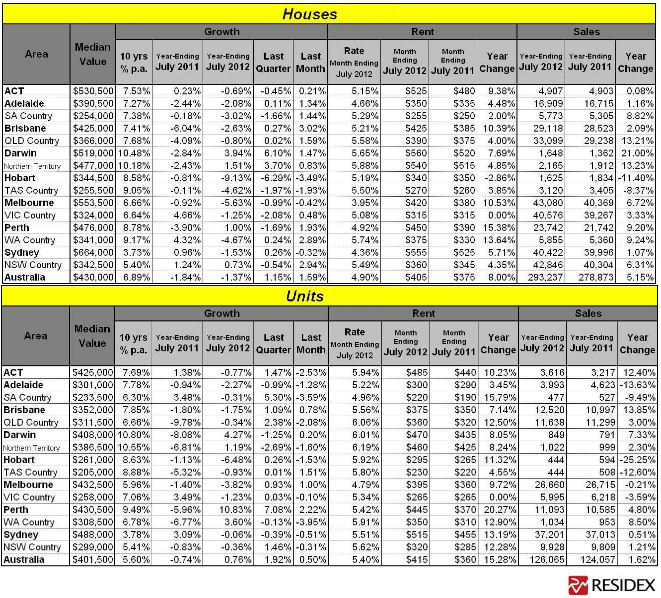
Late last week, Residex released its house price results for the month of July, which registered a rise in house and unit values over the month, but significant divergence between capitals:
In his commentary surrounding the results, Residex CEO, John Edwards, is cautiously optimistic about a housing recovery, but notes risks to the outlook:
On an Australia wide basis, the housing market is strengthening and is once again producing monthly growth that is more in line with the long term trend… However, the market is fragile and any significant international financial shocks will quickly reverse the trend.
The more positive reports coming out of Europe recently indicate that the European Central Bank intends to issue (print) money to ensure there is no collapse of the “union”. This, coupled with the Reserve Bank’s loosening of monetary policy, appears to be having the required impact. The unsettled and fragile nature of the housing market is indicated by the contradictory evidence in the Westpac–Melbourne Institute Index of Consumer Sentiment Survey, which states that consumer sentiment fell by 2.5 per cent in August; down from the July figure of 99.1 per cent to 96.6 per cent.
The return to growth in the house and land market, which is better than what has occurred in the unit market, is a good indicator that lower interest rates are encouraging home owners back into the market – the house and land market is largely the domain of the homeowner…
On the other hand, credit growth numbers and commitments figures produced by the ABS for June are less encouraging. It is likely that activity in June would have been significantly higher than normal due to the final opportunity to benefit from some of the generous buyer stamp duty exemptions in NSW and Victoria, which expired at the end of the financial year. Hence, the modest seasonally adjusted housing commitment growth numbers are of some concern…
Given that incentives for existing properties are largely falling away, an increase in activity in June should have been anticipated in this sector rather than the fall that has been reported by the ABS. In any case, the uplift reported in activity is very small on a seasonally adjusted basis…
There are less negative growth numbers currently than have been seen for some time. The resource states are moving forward. Brisbane and the Gold Coast present as if they are returning to more normal growth patterns and the bottom of their adjustment phases look to have passed.
Markets that are of concern are:
- Hobart, Tasmania
- Sydney, NSW
- Melbourne, Victoria
In the current economic climate, Tasmania is a difficult market given its lack of resource exports and the strength of the Greens Party and its desire to protect the local environment; it now appears that the Gunn’s Paper Mill development will not go ahead. Tasmania needs to find an acceptable road ahead that is not currently evident in a situation where the Australian dollar is high and the Australian economy is heavily reliant on the resource sector for growth…
Sydney is potentially moving back into correction. It is not totally clear why this is occurring. This market moved forward before any other and it had a significant stock shortage. As immigration slowed and unit developments were brought to market in recent months, the stock shortage has diminished to a small volume or slight surplus. This situation is suspected to be impacting on the market. Sydney is now the only capital city other than Hobart to have negative growth in both the unit and house and land market. At this stage, adjustments are small and the trend is only slightly to the downside. The extent and duration of corrections in this market will depend on the volumes of stock generated by new government incentives to first home buyers to stimulate the provision of new stock. It is hoped that new building activity will stimulate the economy and the resource infrastructure projects in the Hunter Valley area will also cause increased immigration. Affordability in Sydney (which is the worst in the nation) will be causing a hidden/unmet demand. Hence this market will respond more than others to Reserve Bank interest rate reductions provided unemployment doesn’t increase and consumer sentiment doesn’t deteriorate further.
The most concerning market is Melbourne… Melbourne’s house and land market is performing more poorly than Sydney. This is understandable given the Residex view that this market has an oversupply of stock and poor affordability of house and land assets. Melbourne is now only marginally better in terms of affordability than Sydney.
The performance of the unit market in Melbourne is more difficult to understand given the current growth profile. However, as evident in the trend graph, growth is moderating and the trend is now definitely to the downside. Residex calculates that Victoria has the largest surplus stock position of all markets in Australia. About 70 per cent of Victoria’s population lives in Melbourne, so it is reasonable to believe that the surplus will mainly be found in the metro area. Further, a visit to Melbourne would probably lead you to believe that this surplus exists in the unit market, and there is also a significant volume of new units to be brought to market over the next 12 months. For this reason, you would expect this market to be showing signs of adjustment; however it is not. The only logical reason for this is the affordable nature of units relative to their location, which is predominately within the inner city precinct. The stock position in Melbourne, which is probably in surplus to the extent of 20,000+ dwellings, is likely to cause significant adjustment in this market over the next 12 months.
Once again it is clear that the “two speed economy” is evidencing itself in housing markets. Resource driven states are starting to move forward while those that are not the lucky beneficiaries of resources activity are struggling. While Sydney and New South Wales as a whole are not seen to be resource driven, the position will most likely change somewhat as the Hunter Valley region becomes more productive.
Twitter: Leith van Onselen. Leith is the Chief Economist of Macro Investor, Australia’s independent investment newsletter covering trades, stocks, property and yield. Click for a free 21 day trial.


